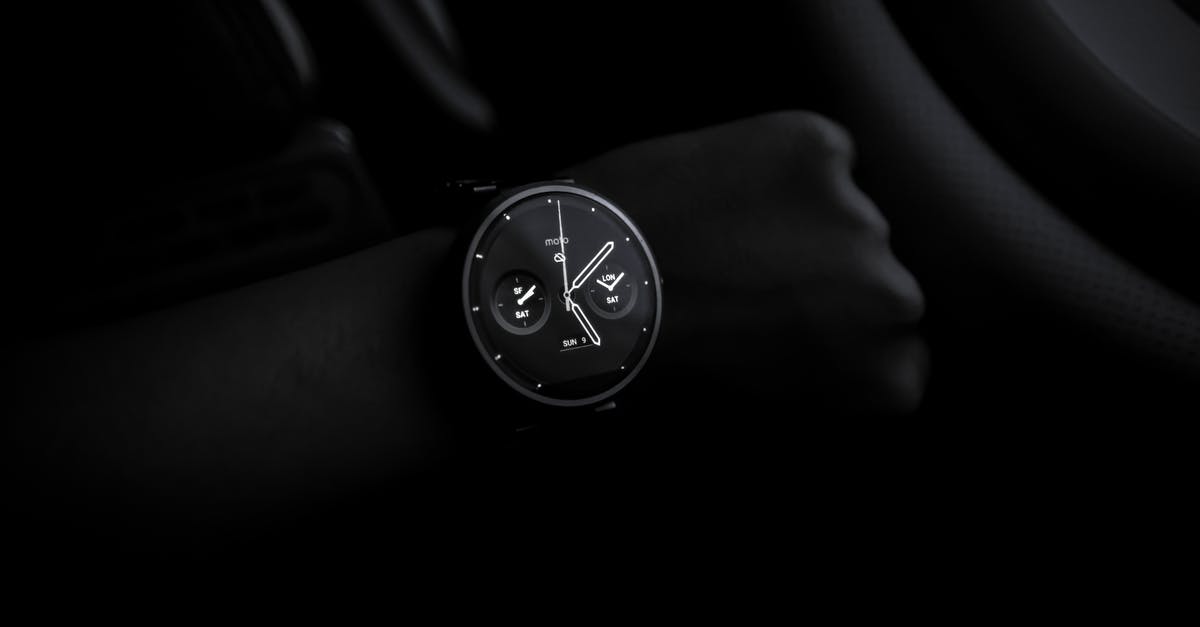How did the watch do what it did?

In Interstellar, after young Murph places the watch on the bookshelf in her bedroom, her father - in the same bedroom but from another dimension - moved the second hand and recorded data in a Morse-signal message on it. Many years later, the second hand still signals the message, grown-up Murph finds the watch and takes it with her to NASA and there she translates the message back into the data needed.
If we assume the watch had a long lasting battery, then I still see some problems with this plot:
- From what we know from the explanation in the movie itself is that the only thing capable to travel from them in the 4th or 5th dimension to present Earth is gravity. Gravity is a vertical force on Earth. It pulled dust from the air to the floor in a barcode-like pattern. So how can it adjust the horizontal position of the second hand of the watch? Like a magnet?
- And how is a multiple of those movements of the second hand recorded on the watch? How does it play the message for all these years, again and again. Not only in Murph's bedroom, but still at NASA too?
Normally I would answer this myself by saying that it is film, it is science fiction, everything is possible, and there is no need to question things we cannot explain. But this movie certainly has the intention of being truthful to science, to explain what is going on and this particular director has a reputation of telling stories that in one way or another always has plausible explanations for plot-hole-like aspects.
Best Answer
For the first question about how gravity could move the watch sideways, apparently the idea was that gravitational waves were being transmitted into the past. In Chapter 30 of The Science of Interstellar by Kip Thorne, the physicist who was the scientific consultant for the movie, it's said that Cooper is scooped out of the black hole by the tesseract, which is a four-dimensional cube in a higher spatial dimension known as "the bulk"--the tesseract seems to be a piece of advanced technology created by the beings living in that dimension, which they used to allow Cooper to transmit the "quantum data" about the black hole singularity to Murph in the past. When he's inside the tesseract, the book says that he can see the "world tubes" of various objects (their paths through spacetime, a sort of 4D tube where each cross-section is the 3D object at a particular instant in time, analogous to the world line of a point particle), and that:
when he pushes on a book's world tube, or on the world tube of the watch's second hand, he generates a gravitational signal (a gravitational wave in the bulk) that spirals into and through the tesseract's bulk interior ... The signal travels forward in local, bulk time, but backward in bedroom time, arriving before it started out. It is this gravitational signal that pushes the book out of the bookcase and twitches the watch's second hand.
Gravitational waves can travel in any direction, so for example we might detect them coming at us in a "sideways" direction if a major source of gravitational waves (like two black holes colliding) had occurred in that direction relative to us. And as explained in this answer on physics stack exchange, they stretch and compress things in a plane that's perpendicular to their direction of motion, so gravitational waves coming in a vertical direction could actually stretch and compress objects in a horizontal plane.
For the second question about how the watch was able to continually play the message, I'll repost my answer from here:
It seems to be a function of the tesseract. From Ch. 30 of The Science of Interstellar:
By the time Cooper has received the quantum data form TARS, he has mastered this means of communication. In the movie we see him pushing with his fingers on the world tube of the watch's second hand. His pushes produce a backwards-in-time gravitational force, which makes the second-hand twitch in a Morse-encoded pattern that carries the quantum data. The tesseract stores the twitching pattern in the bulk so it repeats over and over again. When forty-year-old Murph returns to her bedroom three decades later, she finds the second hand still twitching, repeating over and over again the encoded quantum data that Cooper has struggled so hard to send her.
Pictures about "How did the watch do what it did?"



Mo-Do - Eins Zwei Polizei (Official Video)
More answers regarding how did the watch do what it did?
Answer 2
I think we don't have to rely on the battery of the watch, because if you had noticed the watch was not working, when a grown up Murph took it up. It was not updating time. It was Cooper who was making the second needle move. On how the watch generated data, I think Cooper was using the second needle to transmit data in Morse code.
Morse code is a method of transmitting text information as a series of on-off tones, lights, or clicks that can be directly understood by a skilled listener or observer without special equipment.
On how he was able to use gravity to move the needle, we also notice that gravity is used to disperse sand on the floor and make patterns out of it. So pretty much the same way with clock's needle. But how exactly he could use gravity for making movements along the x-axis is beyond me. May be someone with a deep knowledge of physics could explain whether this is possible. Anyway, we might ask how did he get hold of gravity all? But since according to the story, he could, it doesn't seem so hard to assume that indeed he could make a movement along the x-axis, using gravity.
Answer 3
The 'room' where Cooper is in is essentially a dimension that contains every instance of her daughter's life spent in the room. Time in this dimension is non-linear. This allows Cooper to just walk around and find an instance in time that he chooses.
The watch did not store any information. He was moving the hand at the same time Murphy (the grown up version) was looking at it.
The next part contains some speculation.
The dimension that Cooper is in allows you to affect the gravity of every single thing in the room. In the movie it is likened to the threads attached to a puppet; you can influence it by plucking at it. Yes, I agree that this is quite a stretch from the point of view of Physics, but that is how I see it. There is an instance where they show this in the movie; to move the hand Cooper is pushing against a vertical stream of light which I think is a physical representation of the gravity that is acting on the watch hand.
Answer 4
Regarding your second question:
I had the same question, and now I understand.
As Hypnosifl points out, the tesseract stores the twitching pattern and loops it.
But you might not think this answers the question of why it continues working after the watch has been moved.
Think about it, though. Murph's bedroom is on a spinning planet that's revolving around the sun at 30 km/s, inside of a moving galaxy. Does it really make sense to think that the tesseract is locked onto a specific point in space? No, it's bound to certain matter (everything in Murph's room), not to a certain area in space. It's bound to the books, to the watch. Cooper pushes on the matter in Murph's room, not on the empty space. And that makes sense -- gravity acts on matter.
Sources: Stack Exchange - This article follows the attribution requirements of Stack Exchange and is licensed under CC BY-SA 3.0.
Images: Gustavo Fring, Donald Tong, Karolina Grabowska, Karolina Grabowska
